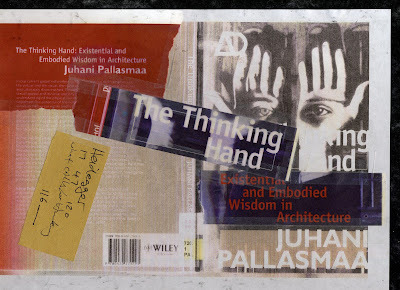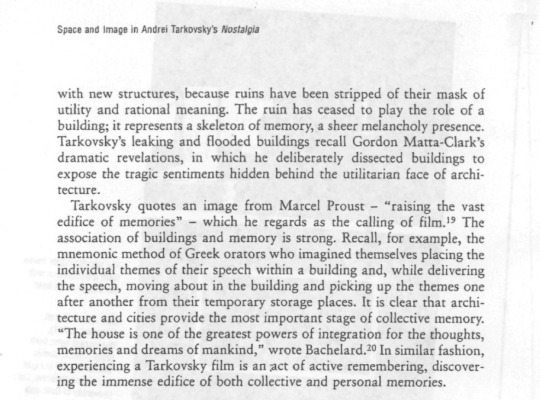#Juhani Pallasmaa
Quote
Touch is the sensory mode which integrates our experiences of the world and of ourselves. Even visual perceptions are fused and integrated into the haptic continuum of the self; my body remembers who I am and how I am located in the world. My body is truly the navel of my world, not in the sense of the viewing point of the central perspective, but as the very locus of reference, memory, imagination and integration. All the senses, including vision, are extensions of the tactile sense; the senses are specialisations of skin tissue, and all sensory experiences are modes of touching, and thus related to tactility. Our contact with the world takes place at the boundary line of the self through specialised parts of our enveloping membrane.
Juhani Pallasmaa, The Eyes of the Skin: Architecture and the Senses
#quote#Juhani Pallasmaa#Pallasmaa#architecture#architectural theory#physiology#sense perception#perception#imagination#human body#sensory#experience#The Eyes of the Skin#memory#biology#observation#seeing#haptic#touch
179 notes
·
View notes
Text


Animal Architecture
20 notes
·
View notes
Text
phenomenological epigraphy
Juhani Pallasmaa’s The Eyes of the Skin

also, Sartre’s ocularphobia

#Juhani Pallasmaa#The Eyes of the Skin#johann wolfgang von goethe#friedrich nietzsche#richard rorty#jorge luis borges#maurice merleau ponty#jean paul sartre
57 notes
·
View notes
Text

Rick Joy Desert Works
2 notes
·
View notes
Photo




(via Inquiry is essentially the way of learning : Fragile Architectures of Hapticity and Time)
#Hapticity#Architecture#Collage#Francesca Woodman#Neil Leach#Bricolage#Environments#Peter Lodermeyer#Andrew Todd#Peter Brook#Juhani Pallasmaa#Jennifer A. H. Shields#Anne Cline#Scriptorium#Tim Ingold#MA Interiors#Waverley Inquiry 2013#Russell Moreton
4 notes
·
View notes
Text
Celebrating the 250th Anniversary of Steingruber's "Architectural Alphabet"
Celebrating the 250th Anniversary of Steingruber’s “Architectural Alphabet”

View On WordPress
#Alfredo Muñoz#Antoni Gaudí#Antonio Basoli#Cees Nagelkerke#Daniel Libeskind#Emily Speed#Galileo Galilei#Geofroy Tory#Giambattista Piranesi#Gilles Deleuze#Giovanni Battista di Pian#Greg Lynn#Heather Hunter#Helen Malone#J. Meejin Yoon#Jeffrey Kipnis#Jeffrey Morin#Johan Hybschmann#Johann David Steingruber#Juhani Pallasmaa#Karen Wirth#Kitty Maryatt#Lanore Cady#Le Corbusier#Mandy Brannan#Marian Macken#Mario Carpo#Marlene MaCallum#Olafur Eliasson#Peter Eisenman
4 notes
·
View notes
Text
Perspective for thought: 001
Words from Finnish architect Juhani Pallasmaa about computer-aided design.
ㅤㅤㅤ
Do computers help more than they hinder? Or do they hinder more than they help? If you asked 100 people, you’d probably get 100 different responses. Everyone will have a different relationship with technology — and beliefs about the benefits of using it as an aide in creative work.
One viewpoint I’m fascinated by is in the excerpt below from Architect Juhani Pallasmaa. Described as a “soft-spoken Finn with big ideas (1),” he shares his perspective on computer-aided design.
For ease of reading (to avoid a wall of text), the passage is separated into three parts:
ㅤㅤㅤ
“The computer is usually seen as a solely beneficial invention, which liberates human fantasy and facilitates efficient design work. I wish to express my serious concern in this respect, at least considering the current role of the computer in education and the design process.
Computer imaging tends to flatten our magnificent, multi-sensory, simultaneous and synchronic capacities of imagination by turning the design process into a passive visual manipulation, a retinal journey. The computer creates a distance between the maker and the object, whereas drawing by hand as well as working with models put the designer in a haptic contact with the object, or space.
In our imagination, the object is simultaneously held in the hand and inside the head, and the imagined and projected physical image is modelled by our embodied imagination. We are inside and outside of the conceived object at the same time. Creative work calls for a bodily and mental identification, empathy and compassion.”
— The Eyes of the Skin: Architecture and the Senses (2)
ㅤㅤㅤ
ㅤㅤㅤ
BACK MATTER:
(1) Craven, Jackie. “Juhani Pallasmaa, The Soft-Spoken Finn With Big Ideas.” ThoughtCo, Feb. 16, 2021, www.thoughtco.com/juhani-pallasmaa-finnish-architect-177421
(2) Pallasmaa, Juhani. “The Eyes of the Skin: Architecture and the Senses,” Wiley, 1996, https://www.goodreads.com/book/show/398621.The_Eyes_of_the_Skin
ㅤㅤㅤ
###
#spilled thoughts#Juhani Pallasmaa#computer aided design#design philosophy#spilled words#spilled writing
0 notes
Text
i’m reading a treatise on architecture called “the eyes of the skin” and it opens by discussing the dominating focus that society places on sight over the other senses—the way something looks being prized far above more haptic things like touch, taste, sound. and it’s alienating—you can look at a thing from a distance but touch is so immediate. it was published in the 90s. i think that effect has only intensified since then. i’m trying to think of experiences that involve as many senses as possible. ways to make the world real. a lived-in thing, not a display
#like genuinely think about it!!#how many things are set up with the primary goal to Look nice? and how many for any of the other senses#food for thought#mine#it’s by juhani pallasmaa#senses
37 notes
·
View notes
Text
“The ruin has ceased to play the role of a building; it represents a skeleton of memory, a sheer melancholy presence.”

Juhani Pallasmaa on Tarkovsky and Proust and Bachelard
23 notes
·
View notes
Text

Everyday Poetry - "The door handle is the handshake of the building." Juhani Pallasmaa
#photography#original photography on tumblr#photographers on tumblr#happiness#quotes#daily calm#art#living
15 notes
·
View notes
Text
Books about game design but not really but really
Collecting my suggestions & others' from a twitter thread (remember those?)
Invisible Cities, Italo Calvino
Pilgrim in the Microworld, David Sudnow
Breathing Machines, Leigh Alexander
Chronicle of a Death Foretold, Gabriel Garcia Marquez
Einstein’s Dreams, Alan Lightman
An Inventory of Losses, Judith Schalansky
Visit to a Small Planet, Elinor Fuchs (https://web.mit.edu/jscheib/Public/foundations_06/ef_smallplanet.pdf)
Noises Off, Michael Freyn
Influence, Robert Cialdini
Ficciones, Jorge Luis Borges
Wonderbook, Jeff VanderMeer
Pale Fire, Vladimir Nabokov
The Westing Game, Ellen Raskin
Motel of the Mysteries, David Macaulay
Ghost Stories for Darwin, Banu Subramaniam (esp. “Singing the Morning Glory Blues”)
Batman: The Animated Series Writer’s Bible (https://dcanimated.com/WF/batman/btas/backstage/wbible/)
Dictionary of the Khazars, Milorad Pavić
The Passion, Jeannette Winterson
Rainbows End, Vernon Vinge
Cat’s Cradle, Kurt Vonnegut
Between the Acts, Virginia Woolf
Where Did You Go? Out. What Did You Do? Nothing., Robert Paul Smith
A Telling of the Tales, William J. Brooke
Finishing The Hat & Look, I Made A Hat, Stephen Sondheim
Finite and Infinite Games, James P. Cause
Exercises in Style, Raymond Queneau
The Design of Everyday Things, Don Norman
Life: A User's Manual, Georges Perec
The Information: A History, A Theory, A Flood, James Gleick
7 1/2 Lessons About The Brain, Lisa Feldman Barrett
additions:
Microserfs, Douglas Coupland
The Eyes of the Skin, Juhani Pallasmaa
House of Leaves, Mark Z. Danielewski
Piranesi, Susanna Clarke
10 notes
·
View notes
Text
Computer imaging tends to flatten our magnificent, multi-sensory, simultaneous and synchronic capacities of imagination by turning the design process into a passive visual manipulation, a retinal journey. The computer creates a distance between the maker and the object, whereas drawing by hand as well as working with models put the designer in a haptic contact with the object, or space. In our imagination, the object is simultaneously held in the hand and inside the head, and the imagined and projected physical image is modelled by our embodied imagination. We are inside and outside of the conceived object at the same time. Creative work calls for a bodily and mental identification, empathy and compassion.
Juhani Pallasmaa, The Eyes of the Skin: Architecture and the Senses
#quote#Juhani Pallasmaa#The Eyes of the Skin#Pallasmaa#architecture#architectural theory#senses#computers#digital#drawing#computer imaging#technology#creativity#design#making
125 notes
·
View notes
Text
"The eye is the organ of distance and separation, whereas touch is the sense of nearness, intimacy and affection. The eye surveys, controls and investigates, whereas touch approaches and caresses. During overpowering emotional experiences, we tend to close off the distancing sense of vision; we close the eyes when dreaming, listening to music, or caressing our beloved ones. Deep shadows and darkness are essential, because they dim the sharpness of vision, make depth and distance ambiguous, and invite unconscious peripheral vision and tactile fantasy. How much more mysterious and inviting is the street of an old town with its alternating realms of darkness and light than are the brightly and evenly lit streets of today! The imagination and daydreaming are stimulated by dim light and shadow. In order to think clearly, the sharpness of vision has to be suppressed, for thoughts travel with an absent-minded and unfocused gaze. Homogenous bright light paralyses the imagination in the same way that homogenisation of space weakens the experience of being, and wipes away the sense of place. The human eye is most perfectly tuned for twilight rather than bright daylight. Mist and twilight awaken the imagination by making visual images unclear and ambiguous; a Chinese painting of a foggy mountain landscape, or the raked sand garden of Ryoan-ji Zen Garden give rise to an unfocused way of looking, evoking a trance-like, meditative state."
Juhani Pallasmaa, The Eyes of the Skin
14 notes
·
View notes
Text
"The ruin has ceased to play the role of a building; it represents a skeleton of memory."
—Tarkovsky's Nostalgia: Notes on a Phenomenology of Architecture, Juhani Pallasmaa.
714 notes
·
View notes
Video
Ceramic Vessel, Lead Tray, Reflected Architecture. by Russell Moreton
Via Flickr:
russellmoreton.blogspot.com/
1 note
·
View note

